Semi-Minimal Pruned Hedge: A Potential Climate Change Adaptation Strategy in Viticulture
Abstract
1. Introduction
2. Materials and Methods
2.1. Experimental Vineyard and Field Trial Design
- -
- Semi-minimal pruned hedge; first shoot topping approximately one week prior to the beginning of flowering (SMPH ST 1)
- -
- Semi-minimal pruned hedge; first shoot topping at the beginning of flowering (SMPH ST 2)
- -
- Semi-minimal pruned hedge; first shoot topping at the end of flowering (SMPH ST 3)
- -
- Semi-minimal pruned hedge; first shoot topping approximately one week after the end of flowering (SMPH ST 4)
- -
- Cane-pruned vertical shoot positioning (VSP) = standard treatment
- -
- Semi-minimal pruned hedge; moderate mechanical thinning with 320 beats/min (SMPH MT 1)
- -
- Semi-minimal pruned hedge; severe mechanical thinning with 370 beats/min (SMPH MT 2)
2.2. Meteorological Data
2.3. Assessment of Bud Burst Percentage and Number of Inflorescences per Shoot
2.4. Assessment of the Cluster Morphology
2.5. Assessment of Botrytis cinerea Disease Progress
2.6. Maturation Progress
2.7. Yield and Total Soluble Solids at Harvest
2.8. Data Analyses and Statistics
3. Results
3.1. Key Meteorological Data
3.2. Percentage of Bud Bursts and Number of Inflorescences Per Cluster
3.3. Cluster Architecture
3.4. Bunch Rot and Maturity Progress
- -
- In 2013, 2015, and 2018, the disease severity for VSP was significantly higher than for each of the SMPH treatments.
- -
- In 2014, the disease severity for VSP was significantly higher than for each of the SMPH treatments with the exception of SMPH ST 2. Besides this, SMPH MT 1 showed significantly lower disease severities than SMPH ST 2.
- -
- In 2017, the disease severity for VSP was significantly higher than for each of the SMPH treatments with the exception of SMPH ST 1. Besides this, SMPH MT 1 and SMPH MT 2 showed significantly lower disease severities than SMPH ST 1.
- -
- In 2016, no significant differences were observed on the final assessment date.
- -
- In 2013, TSS values in VSP and SMPH MT 1 and SMPH MT 2 were significantly higher than in non-thinned SMPH treatments.
- -
- In 2015 and 2018, TSS values in VSP and SMPH MT 2 were significantly higher than in non-thinned SMPH treatments.
- -
- In 2016, TSS in VSP as well as in both thinned SMPH treatments were significantly lower than in SMPH ST 1 and SMPH ST 2.
- -
- In 2014 and 2017, no significant differences were observed on the final assessment date.
3.5. Yield and TSS at Harvest
- -
- In 2013 and 2015, the yield in VSP and SMPH MT 2 was significantly lower than in the non-thinned SMPH treatments.
- -
- In 2016, the yield in VSP was significantly higher than in SMPH ST 1 and SMPH ST 2.
- -
- In 2018, the yield in SMPH MT 1 and SMPH MT 2 was significantly lower than in the non-thinned SMPH treatments.
- -
- In 2014 and 2017, no significant differences were observed.
4. Discussion
4.1. General Behaviour of Non-Thinned SMPH
4.2. Timing of Shoot Topping
4.3. Mechanical Thinning
4.4. Practical Recommendations
4.5. SMPH as a Climate Change Adaptation Strategy
5. Conclusions
Supplementary Materials
Author Contributions
Funding
Acknowledgments
Conflicts of Interest
References
- Kraus, C.; Pennington, T.; Herzog, K.; Hecht, A.; Fischer, M.; Voegele, R.T.; Hoffmann, C.; Töpfer, R.; Kicherer, A. Effects of canopy architecture and microclimate on grapevine health in two training systems. Vitis 2018, 57, 53–60. [Google Scholar]
- Clingeleffer, P.R. Development of management systems for low cost, high quality wine production and vigour control in cool climate Australian vineyards. Wein-Wissenschaft 1993, 48, 130–134. [Google Scholar]
- Intrieri, C.; Filippetti, I.; Allegro, G.; Valentini, G.; Pastore, C.; Colucci, E. The semi-minimal-pruned hedge: A novel mechanized grapevine training system. Am. J. Enol. Viticult. 2011, 62, 312–318. [Google Scholar] [CrossRef]
- Walg, O.; Blätz, M.; Friedel, M. Minimalschnitt im Spalier–eine wirksame Möglichkeit zur Spätfrostprävention. In Deutsches Weinbau-Jahrbuch 2019; Schultz, H.R., Stoll, M., Eds.; Eugen Ulmer KG: Stuttgart, Germany, 2018; Volume 70, pp. 76–85. [Google Scholar]
- Petrie, P.R.; Clingeleffer, P. Crop thinning (hand versus mechanical), grape maturity and anthocyanin concentration: Outcomes from irrigated Cabernet Sauvignon (Vitis vinifera L.) in a warm climate. Aust. J. Grape Wine Res. 2008, 12, 21–29. [Google Scholar] [CrossRef]
- Molitor, D.; Baron, N.; Sauerwein, T.; André, C.M.; Kicherer, A.; Döring, J.; Stoll, M.; Beyer, M.; Hoffmann, L.; Evers, D. Postponing first shoot topping reduces grape cluster compactness and delays bunch rot epidemic. Am. J. Enol. Viticult. 2015, 66, 164–176. [Google Scholar] [CrossRef]
- Lorenz, D.H.; Eichhorn, K.W.; Bleiholder, H.; Klose, R.; Meier, U.; Weber, E. Phenological growth stages of the grapevine, Vitis vinifera L. ssp. vinifera. Codes and descriptions according to the extended BBCH scale. Aust. J. Grape Wine Res. 1995, 1, 100–103. [Google Scholar] [CrossRef]
- Ipach, R.; Huber, B.; Hofmann, H.; Baus, O. Richtlinie zur Prüfung von Wachstumsregulatoren zur Auflockerung der Traubenstruktur und zur Vermeidung von Fäulnis an Trauben. Outline for an EPPO-Guideline; DLR Rheinpfalz: Neustadt an der Weinstraße, Germany, 2005. [Google Scholar]
- Evers, D.; Molitor, D.; Rothmeier, M.; Behr, M.; Fischer, S.; Hoffmann, L. Efficiency of different strategies for the control of grey mold on grapes including gibberellic acid (Gibb3), leaf removal and/or botryticide treatments. J. Int. Sci. Vigne Vin 2010, 44, 151–159. [Google Scholar] [CrossRef]
- Molitor, D.; Hoffmann, L.; Beyer, M. Flower debris removal delays grape bunch rot epidemic. Am. J. Enol. Viticult. 2015, 66, 548–553. [Google Scholar] [CrossRef]
- Beresford, R.M.; Evans, K.J.; Wood, P.N.; Mundy, D.C. Disease assessment and epidemic monitoring methodology for bunch rot (Botrytis cinerea) in grapevines. N. Z. Plant Prot. 2006, 59, 1–6. [Google Scholar]
- Coombe, B.G. Research on development and ripening of the grape berry. Am. J. Enol. Viticult. 1992, 43, 101–110. [Google Scholar]
- Molitor, D.; Biewers, B.; Junglen, M.; Schultz, M.; Clementi, P.; Permesang, G.; Regnery, D.; Porten, M.; Herzog, K.; Hoffmann, L.; et al. Multi-annual comparisons demonstrate differences in the bunch rot susceptibility of nine Vitis vinifera L. cv. Riesling clones. Vitis 2018, 57, 17–25. [Google Scholar]
- Keller, M. The Science of Grapevines. Anatomy and Physiology, 2nd ed.; Elsevier Academic Press: London, UK, 2015. [Google Scholar]
- Tello, J.; Ibanez, J. What do we know about grapevine bunch compactness? A state-of-the-art review. Aust. J. Grape Wine Res. 2017, 24, 6–23. [Google Scholar] [CrossRef]
- Hed, B.; Ngugi, H.K.; Travis, J.W. Relationship between cluster compactness and bunch rot in Vignoles grapes. Plant Dis. 2009, 93, 1195–1201. [Google Scholar] [CrossRef] [PubMed]
- Molitor, D.; Baus, O.; Hoffmann, L.; Beyer, M. Meteorological conditions determine the thermal-temporal position of the annual Botrytis bunch rot epidemic on Vitis vinifera L. cv. Riesling grapes. Oeno One 2016, 50, 231–244. [Google Scholar] [CrossRef]
- Molitor, D.; Behr, M.; Hoffmann, L.; Evers, D. Impact of grape cluster division on cluster morphology and bunch rot epidemic. Am. J. Enol. Viticult. 2012, 63, 508–514. [Google Scholar] [CrossRef]
- Molitor, D.; Junk, J. Climate change is implicating a two-fold impact on air temperature increase in the ripening period under Central European climate conditions. Oeno One 2019. submitted. [Google Scholar]
- Junk, J.; Görgen, K.; Rapisarda, C.; Eickermann, M. Climate change and agriculture: Impact assessment for Luxembourg based on multi-model EURO-CORDEX simulations. Annalen der Meteorologie 2017, 52, 49. [Google Scholar]
- Molitor, D.; Keller, M. Yield of Müller-Thurgau and Riesling grapevines is altered by meteorological conditions in the current and the previous growing seasons. Oeno One 2016, 50, 245–258. [Google Scholar]
- Hill, G.; Stellwaag-Kittler, F.; Huth, G.; Schloesser, E. Resistance of grapes in different developmental stages to Botrytis cinerea. Phytopathologische Zeitschrift 1981, 102, 328–338. [Google Scholar] [CrossRef]
- Kretschmer, M.; Kassemeyer, H.H.; Hahn, M. Age-dependent grey mould susceptibility and tissue-specific defence gene activation of grapevine berry skins after infection by Botrytis cinerea. J. Phytopathol. 2007, 155, 258–263. [Google Scholar] [CrossRef]
- Latif, M. Uncertainty in climate change projections. J. Geochem. Explor. 2011, 110, 1–7. [Google Scholar] [CrossRef]
- Jackson, D.I.; Lombard, P.B. Environmental and management practices affecting grape composition and wine quality—A review. Am. J. Enol. Viticult. 1993, 44, 409–430. [Google Scholar]
- IPCC. Managing the risks of extreme events and disasters to advance climate change adaptation. In A Special Report of Working Groups I and II of the Intergovernmental Panel on Climate Change; Field, C.B., Barros, V., Stocker, T.F., Qin, D., Dokken, D.J., Ebi, K.I., Mastrandrea, M.D., Mach, K.J., Plattner, G.-K., Allen, S.K., et al., Eds.; Cambridge University Press: Cambrige, UK; New York, NY, USA, 2012; p. 582. [Google Scholar]
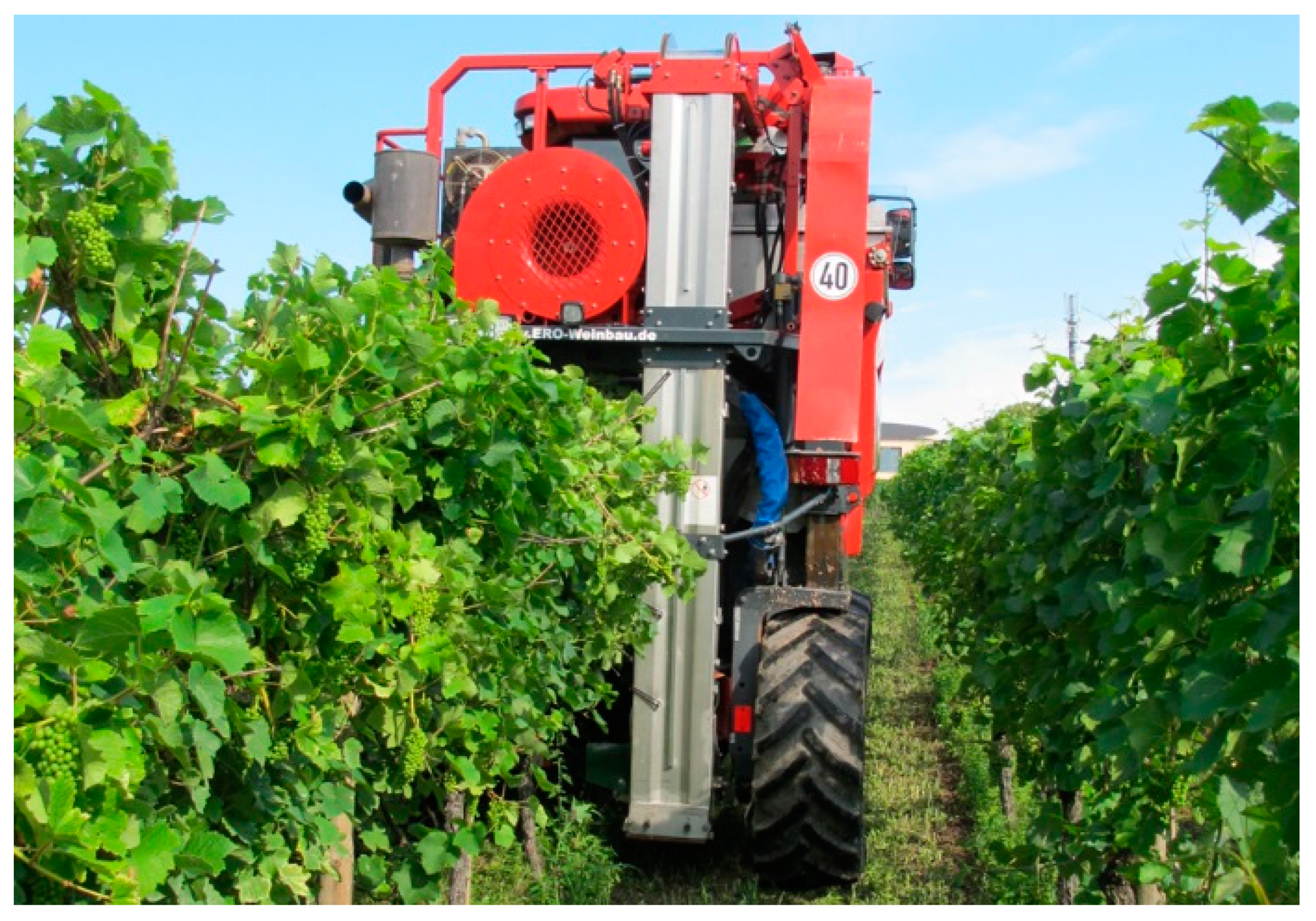
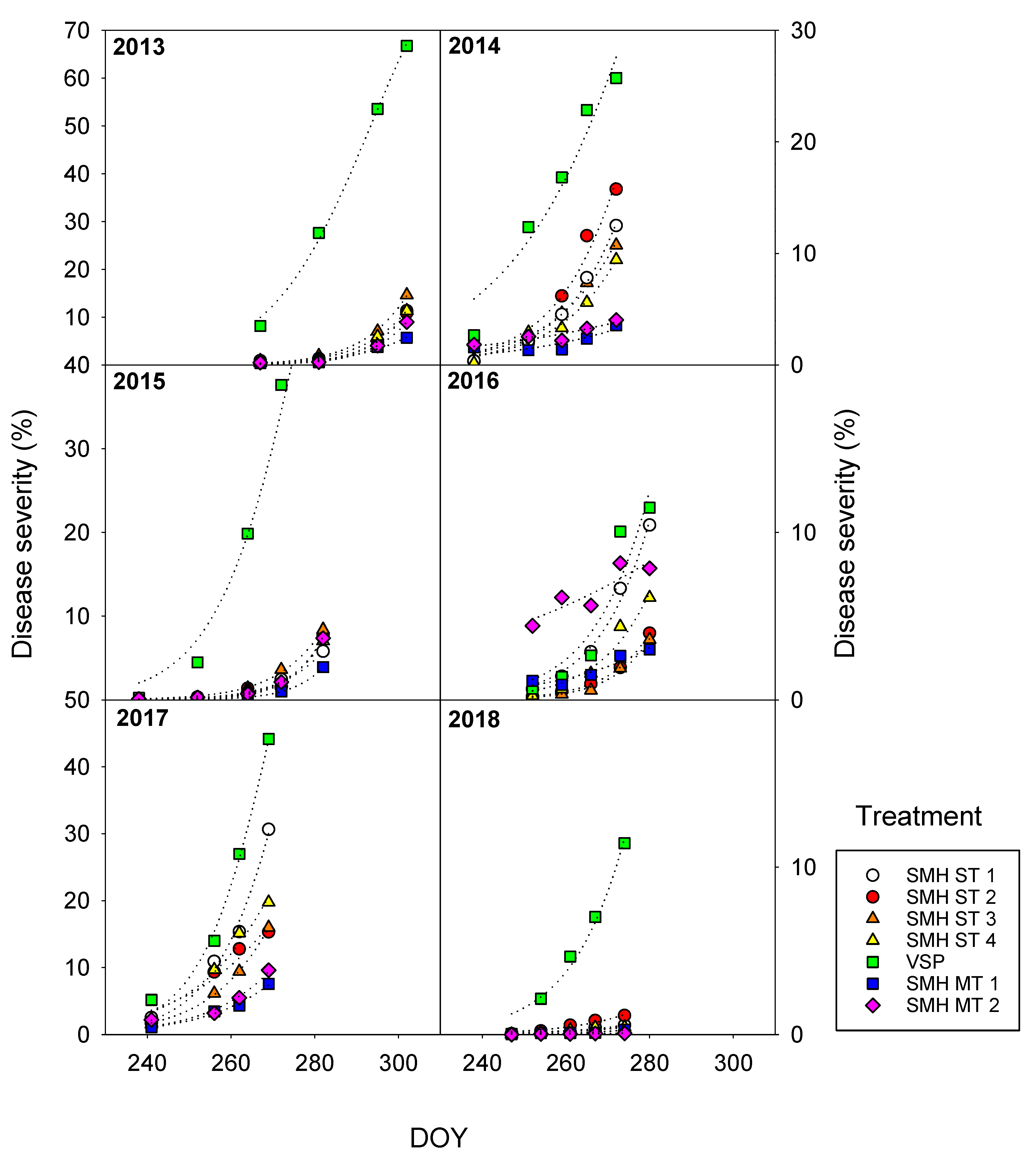
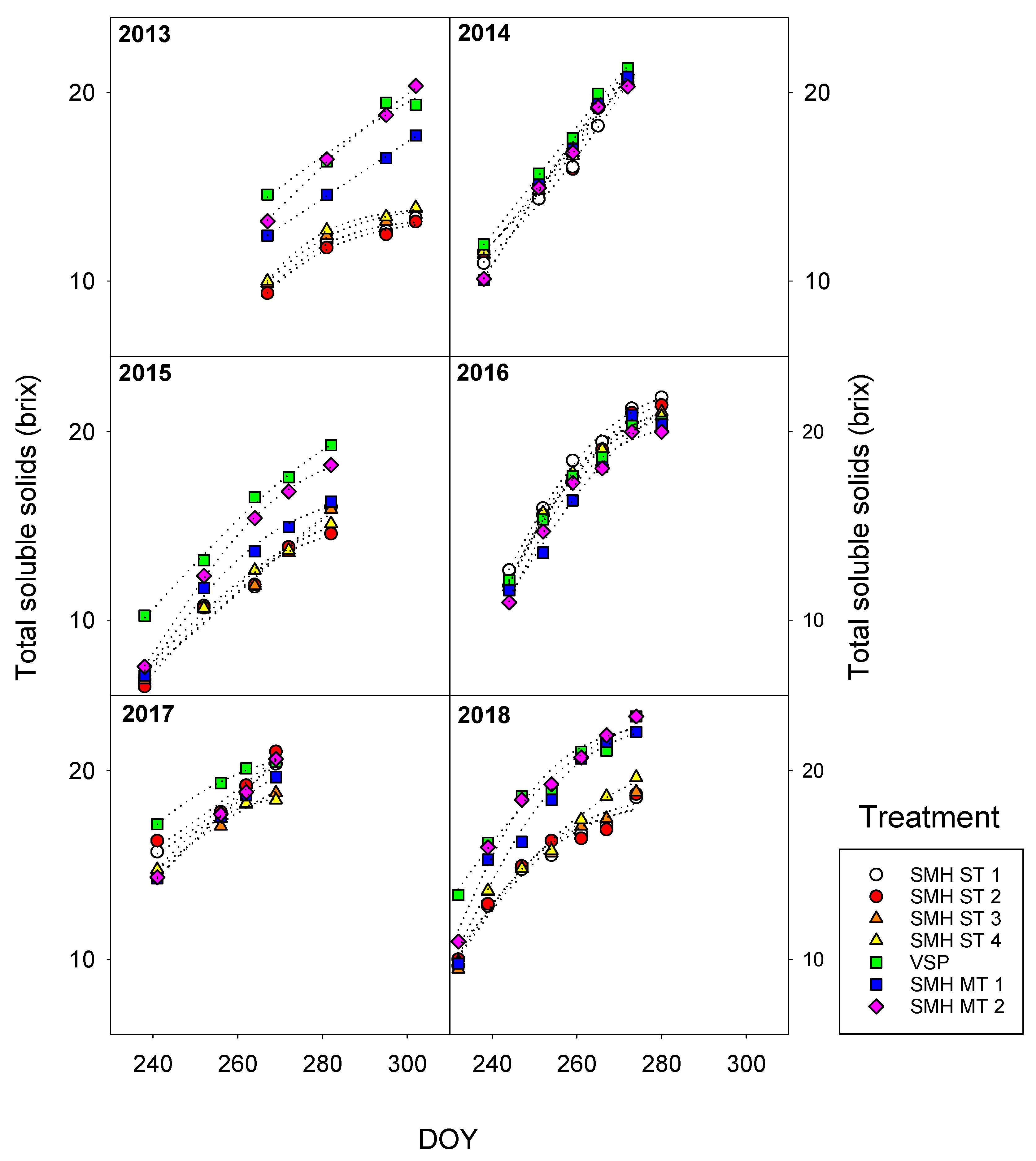
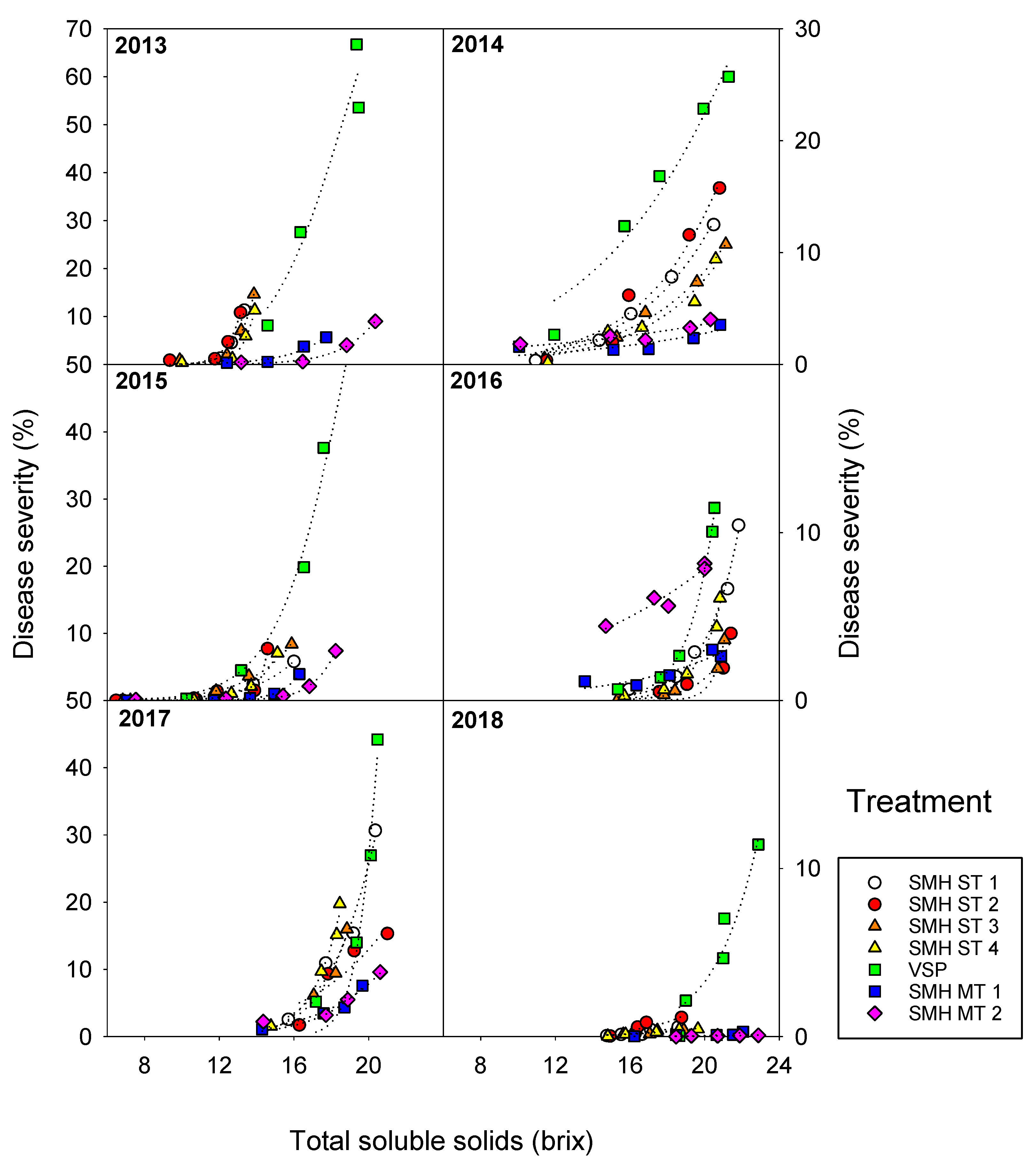
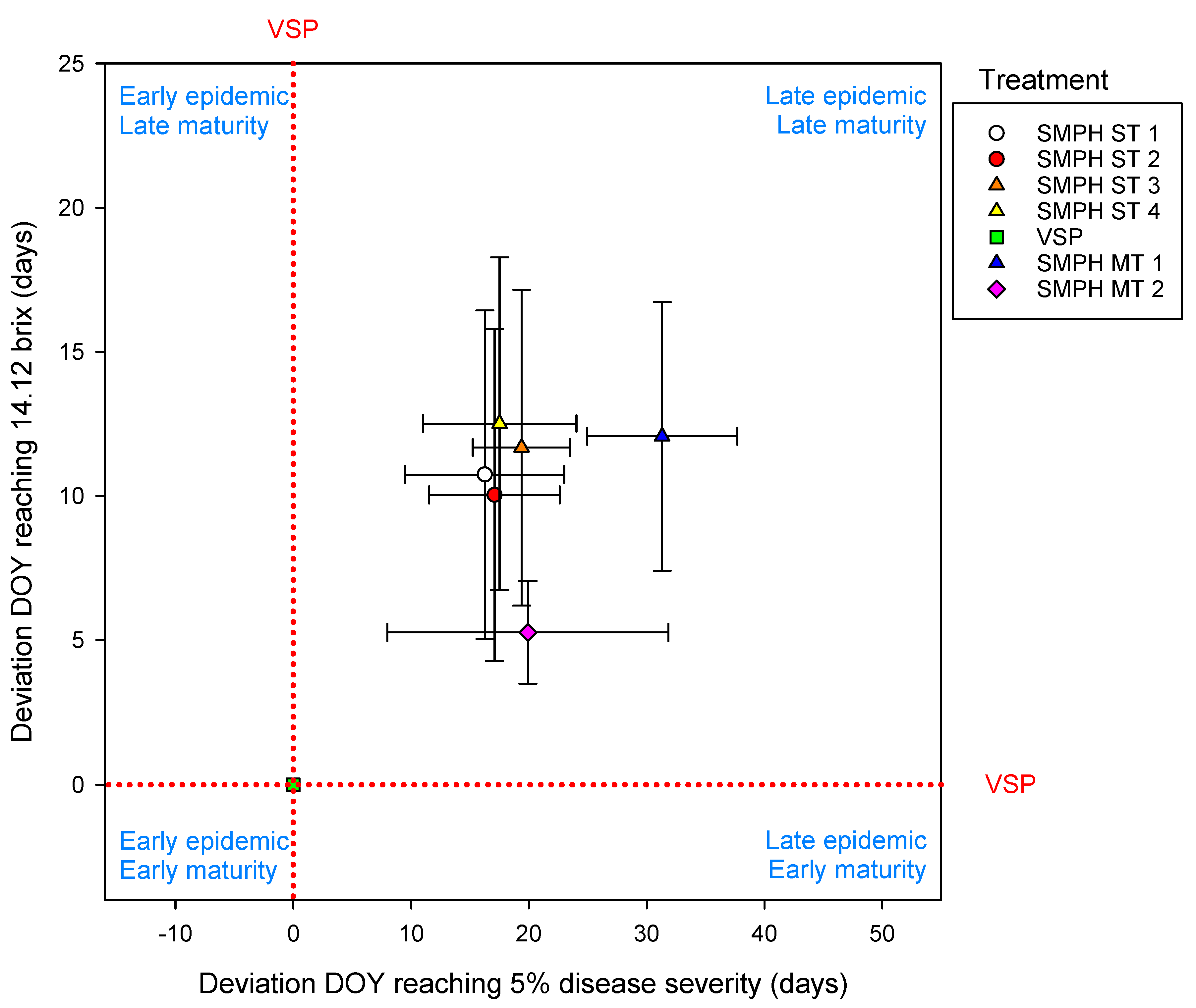
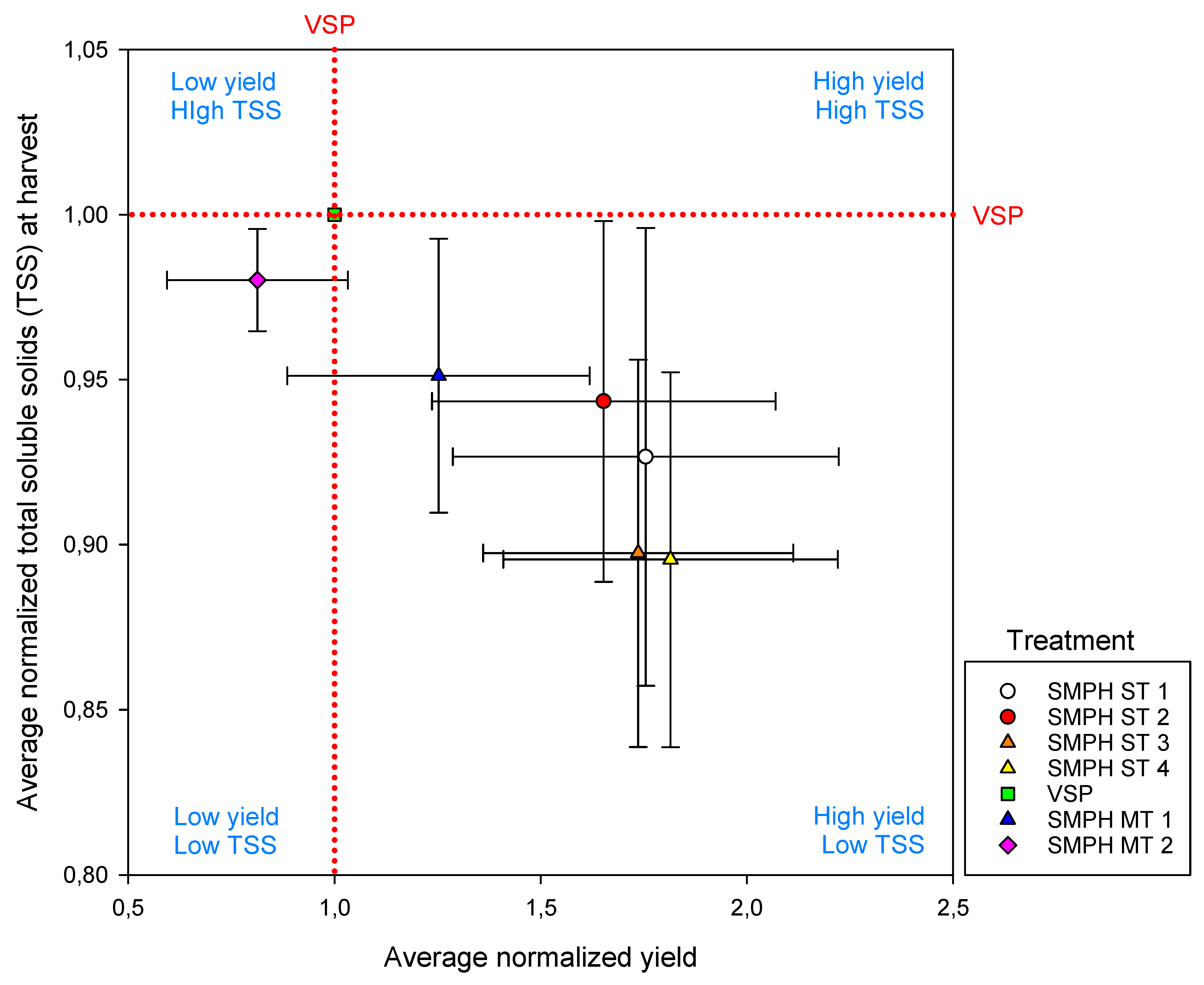
| Treatment * | 2013 | Δ | 2014 | Δ | 2015 | Δ | 2016 | Δ | 2017 | Δ | 2018 | Δ | Average (2014–2017) Δ |
|---|---|---|---|---|---|---|---|---|---|---|---|---|---|
| SMPH ST 1 | 295.2 | 37.0 | 260.2 | 25.6 | 280.4 | 32.6 | 271.1 | 2.5 | 249.3 | 4.3 | 16.3 | ||
| SMPH ST 2 | 295.0 | 36.9 | 256.4 | 21.8 | 278.8 | 31.0 | 282.3 | 13.8 | 246.7 | 1.7 | 17.1 | ||
| SMPH ST 3 | 291.2 | 33.0 | 260.3 | 25.7 | 276.3 | 28.5 | 282.9 | 14.4 | 253.8 | 8.9 | 19.4 | ||
| SMPH ST 4 | 293.4 | 35.3 | 263.2 | 28.6 | 279.0 | 31.2 | 277.1 | 8.5 | 246.7 | 1.7 | 17.5 | ||
| VSP | 258.1 | 0.0 | 234.6 | 0.0 | 247.8 | 0.0 | 268.5 | 0.0 | 244.9 | 0.0 | |||
| SMPH MT 1 | 300.0 | 41.9 | 283.8 | 49.2 | 283.8 | 36.1 | 290.5 | 22.0 | 262.9 | 18.0 | 31.3 | ||
| SMPH MT 2 | 296.8 | 38.7 | 282.7 | 48.1 | 278.8 | 31.0 | 253.9 | −14.7 | 260.1 | 15.2 | 19.9 | ||
| Average | 290.0 | 31.8 | 263.0 | 28.1 | 275.0 | 27.2 | 275.2 | 6.6 | 252.1 | 7.1 | 17.3 |
| Treatment | 2013 | Δ | 2014 | Δ | 2015 | Δ | 2016 | Δ | 2017 | Δ | 2018 | Δ | Average (2014–2018) Δ |
|---|---|---|---|---|---|---|---|---|---|---|---|---|---|
| SMPH ST 1 | NR * | 251.0 | 5.3 | 272.9 | 18.2 | 246.7 | −1.8 | 230.5 | 2.8 | 242.3 | 29.3 | 10.7 | |
| SMPH ST 2 | NR | 249.1 | 3.3 | 276.8 | 22.1 | 247.6 | −0.9 | 227.6 | −0.2 | 238.8 | 25.9 | 10.0 | |
| SMPH ST 3 | NR | 247.8 | 2.1 | 273.5 | 18.8 | 247.5 | −1.0 | 237.5 | 9.8 | 241.7 | 28.8 | 11.7 | |
| SMPH ST 4 | NR | 248.2 | 2.5 | 273.7 | 19.0 | 247.6 | −0.9 | 238.8 | 11.0 | 243.9 | 31.0 | 12.5 | |
| VSP | 265.0 | 0.0 | 245.8 | 0.0 | 254.7 | 0.0 | 248.5 | 0.0 | 227.8 | 0.0 | 213.0 | 0.0 | 0.0 |
| SMPH MT 1 | 278.4 | 13.3 | 249.1 | 3.3 | 264.9 | 10.2 | 253.4 | 4.9 | 240.3 | 12.5 | 242.5 | 29.5 | 12.1 |
| SMPH MT 2 | 271.0 | 5.9 | 249.2 | 3.5 | 258.5 | 3.8 | 250.3 | 1.8 | 239.8 | 12.0 | 218.2 | 5.3 | 5.3 |
| Average | 248.6 | 2.8 | 267.8 | 13.1 | 248.8 | 0.3 | 234.6 | 6.8 | 243.3 | 21.4 | 8.9 |
| Treatment | 2013 | Δ | 2014 | Δ | 2015 | Δ | 2016 | Δ | 2017 | Δ | 2018 | Δ | Average (2014–2017) Δ |
|---|---|---|---|---|---|---|---|---|---|---|---|---|---|
| SMPH ST 1 | 12.8 | 0.0 | 16.8 | 5.6 | 15.6 | 2.2 | 20.6 | 1.2 | 16.7 | −2.0 | 1.8 | ||
| SMPH ST 2 | 12.6 | −0.2 | 16.2 | 5.0 | 14.4 | 1.0 | 21.9 | 2.5 | 16.3 | −2.4 | 1.5 | ||
| SMPH ST 3 | 12.9 | 0.2 | 17.8 | 6.6 | 14.6 | 1.2 | 21.3 | 1.9 | 16.9 | −1.7 | 2.0 | ||
| SMPH ST 4 | 13.4 | 0.6 | 18.4 | 7.2 | 14.7 | 1.3 | 20.7 | 1.2 | 16.6 | −2.0 | 1.9 | ||
| VSP | 12.7 | 0.0 | 11.2 | 0.0 | 13.4 | 0.0 | 19.4 | 0.0 | 18.6 | 0.0 | 0.0 | ||
| SMPH MT 1 | 17.4 | 4.7 | 24.8 | 13.6 | 16.5 | 3.1 | 23.9 | 4.5 | 18.7 | 0.1 | 5.3 | ||
| SMPH MT 2 | 19.3 | 6.6 | 23.9 | 12.7 | 17.8 | 4.4 | 16.0 | -3.4 | 18.6 | −0.1 | 3.4 | ||
| Average | 14.4 | 1.7 | 18.5 | 7.2 | 15.3 | 1.9 | 20.5 | 1.1 | 17.5 | −1.1 | 2.3 |
| Treatment | 2013 | 2014 | 2015 | 2016 | 2017 | 2018 | Average Normalized Yield (2014–2018) |
|---|---|---|---|---|---|---|---|
| SMPH ST 1 | 9.5 c | 3.8 | 12.5 b | 0.9 a | 5.3 | 7.6 bc | 1.8 |
| SMPH ST 2 | 8.8 bc | 3.8 | 11.6 b | 0.9 a | 4.5 | 8.0 c | 1.7 |
| SMPH ST 3 | 9.2 c | 4.6 | 11.4 b | 1.4 ab | 4.9 | 7.5 bc | 1.7 |
| SMPH ST 4 | 7.6 bc | 4.4 | 11.3 b | 1.6 ab | 5.5 | 7.8 bc | 1.8 |
| VSP | 3.3 a | 3.7 | 4.8 a | 2.7 b | 1.9 | 3.7 ab | 1.0 |
| SMPH MT 1 | 4.8 ab | 3.2 | 8.4 ab | 1.2 ab | 4.7 | 2.8 a | 1.3 |
| SMPH MT 2 | 2.1 a | 2.6 | 6.4 a | 1.0 a | 2.5 | 1.2 a | 0.8 |
| Average | 6.5 | 3.7 | 9.5 | 1.4 | 4.2 | 5.5 | 1.4 |
| Treatment | 2013 | 2014 | 2015 | 2016 | 2017 | 2018 | Average Normalized TSS at Harvest (2014–2018) |
|---|---|---|---|---|---|---|---|
| SMPH ST 1 | 12.9 a | 21.1 | 13.3 a | 22.3 b | 20.4 | 19.7 | 0.9 |
| SMPH ST 2 | 12.7 a | 20.8 | 15.0 ab | 21.8 ab | 21.0 | 19.7 | 0.9 |
| SMPH ST 3 | 13.4 a | 20.5 | 13.6 a | 21.5 ab | 18.8 | 19.2 | 0.9 |
| SMPH ST 4 | 13.4 a | 20.6 | 13.7 a | 21.3 ab | 18.5 | 19.4 | 0.9 |
| VSP | 18.9 c | 21.3 | 19.0 c | 20.3 a | 20.5 | 23.2 | 1.0 |
| SMPH MT 1 | 17.3 b | 20.8 | 15.1 ab | 21.0 ab | 19.7 | 22.9 | 1.0 |
| SMPH MT 2 | 19.9 c | 20.3 | 17.8 bc | 20.4 a | 20.6 | 23.2 | 1.0 |
| Average | 15.5 | 20.8 | 15.4 | 21.2 | 19.9 | 21.0 | 0.9 |
© 2019 by the authors. Licensee MDPI, Basel, Switzerland. This article is an open access article distributed under the terms and conditions of the Creative Commons Attribution (CC BY) license (http://creativecommons.org/licenses/by/4.0/).
Share and Cite
Molitor, D.; Schultz, M.; Mannes, R.; Pallez-Barthel, M.; Hoffmann, L.; Beyer, M. Semi-Minimal Pruned Hedge: A Potential Climate Change Adaptation Strategy in Viticulture. Agronomy 2019, 9, 173. https://doi.org/10.3390/agronomy9040173
Molitor D, Schultz M, Mannes R, Pallez-Barthel M, Hoffmann L, Beyer M. Semi-Minimal Pruned Hedge: A Potential Climate Change Adaptation Strategy in Viticulture. Agronomy. 2019; 9(4):173. https://doi.org/10.3390/agronomy9040173
Chicago/Turabian StyleMolitor, Daniel, Mareike Schultz, Robert Mannes, Marine Pallez-Barthel, Lucien Hoffmann, and Marco Beyer. 2019. "Semi-Minimal Pruned Hedge: A Potential Climate Change Adaptation Strategy in Viticulture" Agronomy 9, no. 4: 173. https://doi.org/10.3390/agronomy9040173
APA StyleMolitor, D., Schultz, M., Mannes, R., Pallez-Barthel, M., Hoffmann, L., & Beyer, M. (2019). Semi-Minimal Pruned Hedge: A Potential Climate Change Adaptation Strategy in Viticulture. Agronomy, 9(4), 173. https://doi.org/10.3390/agronomy9040173






